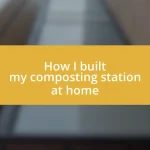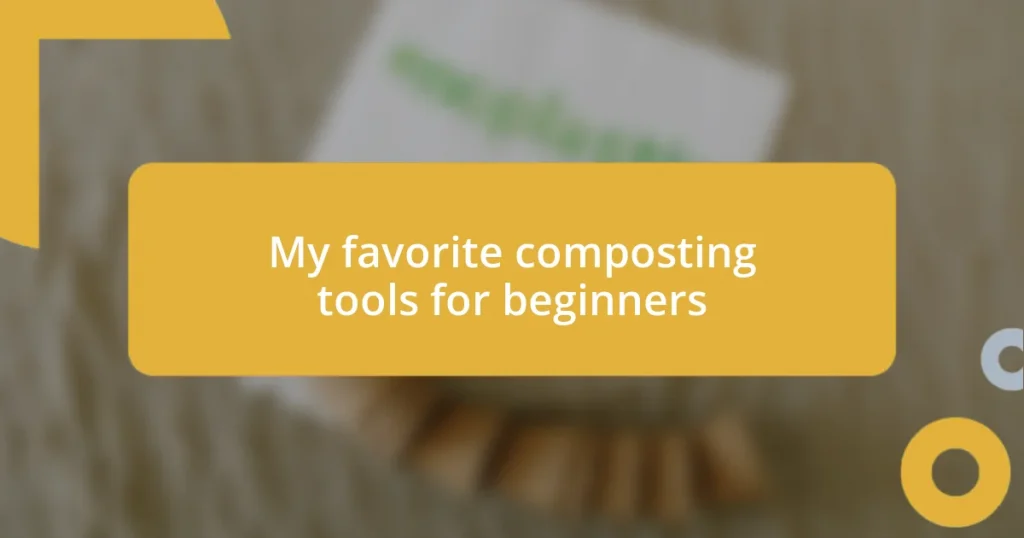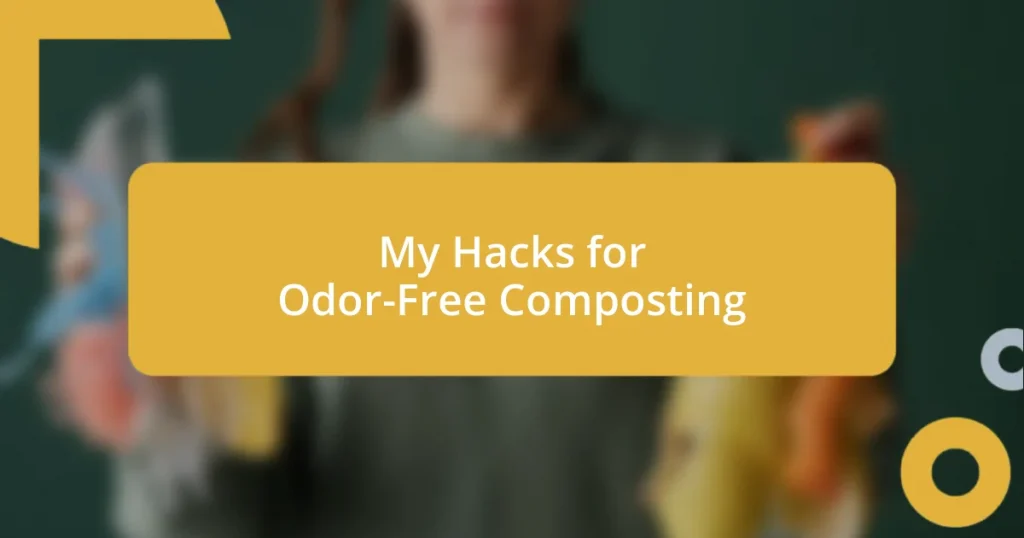Key takeaways:
- Aerated composting accelerates decomposition and improves compost quality by enhancing oxygen flow, leading to healthier, nutrient-rich soil.
- Common aerated composting techniques include passive aeration (manual turning), forced aeration (using blowers), and mechanical tumblers (for easy turning), each with distinct advantages.
- Maintaining an aerated composting system involves regular turning, managing moisture levels, and ensuring proper airflow to support microbial activity and prevent odor issues.

Introduction to Aerated Composting
Aerated composting is an innovative practice that enhances the decomposition process by actively increasing oxygen flow to the materials. I remember my first attempt at composting; I was overwhelmed by the sheer number of ways to do it. Suddenly, aerated composting appeared to be the golden ticket, promising richer, faster results by creating a dynamic environment for microorganisms to thrive.
When I started using aerated composting techniques, I was amazed at how quickly my kitchen scraps began to transform into nutrient-rich soil. It was like watching magic happen in my backyard! The key idea here is that by incorporating aeration, compost heats up more rapidly, which not only speeds up decomposition but also helps eliminate harmful pathogens. Who wouldn’t want healthier compost, right?
In my experience, the beauty of aerated composting lies in its simplicity and effectiveness. The process can involve simple methods like turning the pile regularly or using mechanical systems to blow air through the compost. This level of control allowed me to experiment and see what worked best, leading to a deeper understanding of the composting process itself. It’s both rewarding and educational, and I can’t help but wonder how many people are missing out on this enriching experience!

Benefits of Aerated Composting
One of the most significant benefits of aerated composting is the reduction of odors. Before I embraced this technique, my traditional compost pile was a source of unwelcome smells, especially during hot summer days. With aeration, the decomposition process becomes aerobic, which significantly diminishes those unpleasant scents. It’s amazing how simply introducing more oxygen not only enhances the efficiency of composting but also transforms your space into a fragrant, earthy haven.
- Faster decomposition: Aerated composting can reduce the time it takes to transform organic waste into usable compost.
- Healthier compost: The increased oxygen levels promote the growth of beneficial microorganisms, which crowd out pathogens.
- Improved quality: You end up with nutrient-rich compost that enhances plant growth and soil health.
- Fewer pests: With reduced odors and a quicker process, fewer pests are attracted to the compost pile.
I’ve noticed that my garden flourishes better with aerated compost. It feels satisfying to see the plants thriving, knowing that I contributed to their health through a method that’s both environmentally friendly and efficient. Engaging in this process has not only enriched my garden but also brought me a lasting connection with the cycles of nature.

Types of Aerated Composting Techniques
Aerated composting techniques come in various forms, each offering unique advantages. In my journey, I encountered three main methods: passive aeration, forced aeration, and mechanical tumblers. Passive aeration relies on simply turning the pile manually, which feels like a workout session every time! While it requires a bit more effort, I found that the physical act of turning the pile connected me to the compost and made the whole process feel more rewarding.
On the other hand, forced aeration utilizes blowers or fans to pump air through the compost. In my experience, this method speeds up decomposition considerably, but I must admit, it felt a bit impersonal at times. That said, the efficiency gained was impressive; I could practically see the steam rising from the pile! Lastly, mechanical tumblers offer a compromise between the two, allowing for an easy, straightforward turning process. I remember my first tumbler—it felt like a game changer for my composting routine, significantly cutting down on the physical labor required.
Understanding the different types of aerated composting techniques helped me tailor my approach based on my space and lifestyle. The decision really comes down to personal preference and needs. What works for one gardener might not suit another, and that’s the beauty of composting—there’s always a way to make it fit one’s personal style.
| Technique | Description |
|---|---|
| Passive Aeration | Manually turning the compost pile to allow air flow. |
| Forced Aeration | Using blowers or fans to pump air into the compost. |
| Mechanical Tumblers | Utilizing tumblers for easy compost turning with less physical effort. |

Best Materials for Aerated Composting
When it comes to choosing the best materials for aerated composting, I’ve learned that a balanced mix is crucial. I typically find that a combination of greens—like kitchen scraps and grass clippings—and browns—such as dry leaves and shredded cardboard—creates the ideal environment for aeration. Have you ever noticed how each material comes alive in the composting process? The vibrant greens energize the mix, while the browns provide the structure necessary for airflow.
I’ve had my share of trial and error with materials. Initially, I didn’t pay enough attention to the size of my compost pieces. Larger chunks would clump together, restricting airflow and slowing down the process. After some frustrating waits, I realized that chopping or shredding the materials made a significant difference. Now, I make it a point to keep my scraps finely cut—like my own mini-chop shop for compost! This simple change has not only sped up decomposition but also improved the overall quality of my compost.
Another key factor I’ve discovered through my experience is moisture content. While it’s essential to keep everything damp, too much water can lead to sogginess and anaerobic conditions—definitely not what you want! I often check the moisture level by squeezing a handful of compost; if it holds its shape but isn’t dripping, I know I’m on the right track. This attention to detail can make all the difference in achieving that nutrient-rich compost that our gardens crave. How do you ensure your compost materials are just right?

Troubleshooting Aerated Composting Issues
Issues can arise in aerated composting, and I’ve faced them myself. One of the most common problems I’ve encountered is odor. If my compost starts to smell bad, it usually means there’s an imbalance, often too much nitrogen-rich material like kitchen scraps. To fix this, I remember adding more browns, like dried leaves or shredded newspaper, which helped restore that pleasant earthy scent. Have you ever noticed how a good compost should smell almost like a forest floor?
Another issue that can pop up is a lack of temperature in the pile. When I first started aerated composting, I was thrilled by the heat buildup during the process. However, I recently let a pile almost cool down completely because I forgot to turn it regularly. When that happens, it can mean oxygen isn’t circulating well. I took immediate action by reinvigorating the pile with some turning and ensured I incorporated more air holes. It was rewarding to feel the heat return, a reminder of the life happening inside the compost!
If you notice your compost is too wet, it can lead to anaerobic conditions. I faced this when a heavy rainstorm hit, and my bin became a soupy mess. I learned that the best remedy is to mix in dry materials like straw or sawdust to absorb the excess moisture and restore balance. Keeping an eye on those moisture levels is a game changer, don’t you think? It’s moments like this that remind me how dynamic composting is—it truly feels like a relationship with nature that constantly evolves.

Maintaining Aerated Composting Systems
Maintaining an aerated composting system is like nurturing a living ecosystem; it requires patience and attention. I’ve found that regularly turning the compost pile not only distributes moisture and heat but also really invigorates the microbial activity. Whenever I’ve lagged on turning, I noticed the compost would stagnate, and that’s when I realized, it’s all about consistency. Isn’t it fascinating how a simple act can breathe new life into your pile?
Moisture management is another key aspect I pay close attention to. I remember a time when I got too absorbed in the process, and my compost bin became a soggy mess—an experience I won’t forget! Now, I always keep a tarp on hand to protect my compost from unexpected rain, which has helped me maintain that perfect balance of moisture. Have you ever watched how the moisture bubbles up when you turn the pile? It’s both a sight and a sensation that transforms the mundane into the magical!
Finally, I’ve learned that aeration isn’t just about turning the pile; it’s about fostering airflow throughout. I often poke holes in the compost with a pitchfork to ensure oxygen flows freely. Each time I do this, it feels like I’m giving a little gift to the microorganisms. It’s uplifting to visualize how this simple interaction supports life. How often do you check your aeration? The more engaged I become in this process, the more rewarding it feels when I finally harvest rich, dark compost at the end!














